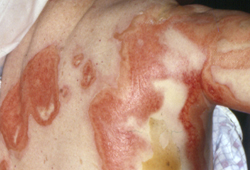Summary
Definition
History and exam
Key diagnostic factors
- რისკ-ფაქტორების არსებობა
- გამონაყარი
- ლორწოვანი გარსის ჩართვა
- ნიკოლსკის სიმპტომი
- წყლულები
Risk factors
- პაციენტები კიბოს აქტიური ფორმით
- ანტიკონვულსიური მედიკამენტები
- ახლადინფიცირებული პაციენტი
- ანტიბიოტიკების გამოყენება ახლო წარსულში
- სხვა მედიკამენტები
- სისტემური წითელი მგლურა
- აივ-დადებითი
- სხივური თერაპია
- ადამიანის ლეიკოციტური ანტიგენი და გენეტიკური წინასწარგანწყობა
- ყვავილის საწინააღმდეგო ვაქცინაცია
- ძვლის ტვინის ტრანსპლანტაცია
Diagnostic tests
1st tests to order
- კანის ბიოფსია
- სისხლის კულტურები
- სისხლის საერთო ანალიზი
- გლუკოზა
- მაგნიუმი
- ფოსფატი
- შარდოვანა
- ბიკარბონატი
- სისხლის შრატში ელექტროლიტების შემცველობა
- სისხლის შრატის კრეატინინი
- ღვიძლის ფუნქციური სინჯები
- ერითროციტების დალექვის სიჩქარე
- C- რეაქტიული ცილა
- არტერიული სისხლის აირები და ჟანგბადით გაჯერება (ჟანგბადის სატურაცია)
- გულმკერდის რენტგენოგრაფია (რენტგენი)
- კოაგულოგრამა
- კანის ნაცხი დაზიანებული კანიდან
- მიკოპლაზმის სეროლოგია
Tests to consider
- პირდაპირი იმუნოფლუორესცენცია
Treatment algorithm
ყველა პაციენტის
Contributors
Authors
Areta Kowal-Vern, MD
Adjunct Research Faculty
Arizona Burn Center
Valleywise Health Medical Center
Phoenix
AZ
Disclosures
AK-V performs occasional manuscript reviews on various topics for Research Square, Inc. and the Journal of Burn Care and Research in the US for which she receives a nominal monetary fee. AK-V is an author of a reference cited in this topic.
Peer reviewers
Barbara A. Latenser, MD
Director Burn Unit
Department of Surgery
University of Iowa Hospitals
Iowa City
IA
Disclosures
BAL declares that she has no competing interests.
Tina Palmieri, MD
Assistant Chief of Burns
Shriners Hospital
UC Davis
Sacramento
CA
Disclosures
TP declares that she has no competing interests.
Venkat Gudi, MB BS
Consultant Dermatologist
Department of Dermatology
West Suffolk Hospital
Bury St. Edmunds
UK
Disclosures
VG declares that he has no competing interests.
Peer reviewer acknowledgements
BMJ Best Practice topics are updated on a rolling basis in line with developments in evidence and guidance. The peer reviewers listed here have reviewed the content at least once during the history of the topic.
Disclosures
Peer reviewer affiliations and disclosures pertain to the time of the review.
References
Key articles
Bastuji-Garin S, Rzany B, Stern RS, et al. Clinical classification of cases of toxic epidermal necrolysis, Stevens-Johnson syndrome, and erythema multiforme. Arch Dermatol. 1993 Jan;129(1):92-6. Abstract
Creamer D, Walsh SA, Dziewulski P, et al. UK guidelines for the management of Stevens-Johnson syndrome/toxic epidermal necrolysis in adults 2016. Br J Dermatol. 2016 Jun;174(6):1194-227.Full text Abstract
Seminario-Vidal L, Kroshinsky D, Malachowski SJ, et al. Society of Dermatology Hospitalists supportive care guidelines for the management of Stevens-Johnson syndrome/toxic epidermal necrolysis in adults. J Am Acad Dermatol. 2020 Jun;82(6):1553-67. Abstract
Gregory DG. New grading system and treatment guidelines for the acute ocular manifestations of Stevens-Johnson syndrome. Ophthalmology. 2016 Aug;123(8):1653-8. Abstract
Reference articles
A full list of sources referenced in this topic is available to users with access to all of BMJ Best Practice.

Differentials
- მედიკამენტური გამონაყარი ეოზინოფილიითა და სისტემური სიმპტომებით (DRESS)
- სტაფილოკოკური დათუთქული კანის სინდრომი
- ტოქსიური შოკის სინდრომი
More DifferentialsGuidelines
- Supportive care guidelines for the management of Stevens-Johnson syndrome/toxic epidermal necrolysis in adults
- Management of Stevens-Johnson syndrome/toxic epidermal necrolysis in children and young people (0 to 17 years)
More GuidelinesLog in or subscribe to access all of BMJ Best Practice
Use of this content is subject to our disclaimer